算法导论第二十五章答案
- 格式:doc
- 大小:6.90 MB
- 文档页数:47


![算法导论(第三版)-复习-第六部分图论22-26[转]](https://uimg.taocdn.com/056830c148649b6648d7c1c708a1284ac85005ae.webp)
算法导论(第三版)-复习-第六部分图论22-26[转]22习题22.1-5 有向图G(V, E)的平⽅图。
链表表⽰时,对每结点u的Adj[u]中所有v加⼊队列,后边出队边将Adj[v]加⼊Adj[u]中。
矩阵表⽰时,若w[i, j]、w[j, k]同时为1则将w[i, k]置1.习题22.1-6 O(V)的时间寻找通⽤汇点。
汇点的特征是邻接矩阵的第j列除[j, j]外所有元素为1. 可将每⾏调整[j ,j]后作为⼀个整数,所有整数与运算,为1的位是汇点。
习题22.1-7 有向⽆环图的关联矩阵B,BB’每个元素C[i, j]=∑B[i, k]*B’[k, j]=∑B[i, k]*B[j, k],即同时进i, j两结点与同时出i, j的结点总数-⼀进⼀出i, j两结点的结点总数。
习题22.2-7 类似BFS,d mod2为0则标为B(娃娃脸),d mod2为1则标为H(⾼跟鞋)。
但若有边连接相同类的结点,则⽆法划分。
wrestler(G){for each u in G{(u,v)=Adj[u];if(v.mark==u.mark){throw error;}if(v.d==NIL) {v.d=u.d+1; v.mark=v.d mod 2;}}}习题22.2-8 任意点之间的最短路径。
重复的Dijktra算法或Floyd-Warshall算法习题22.2-9 ⽆向图扩展为有向图。
问题变成要遍历所有边⼀次。
访问结点u时,将u的⼦结点v的其他边都可视为⼦集v,问题等价于u到v,访问v的集合,v到u。
u标为visiting⼊列,然后访问v,v标为visiting⼊列,然后访问v的后继结点,访问过的边标为visited,返回到visiting的点时,如果该点所有连接的边都标为visited只剩⼀条返回上级的边,则返回上级结点并将点标为visited,v出列,访问u的其他⼦结点,最终u出列。
全部结点出列后达到遍历所有边⼀次。
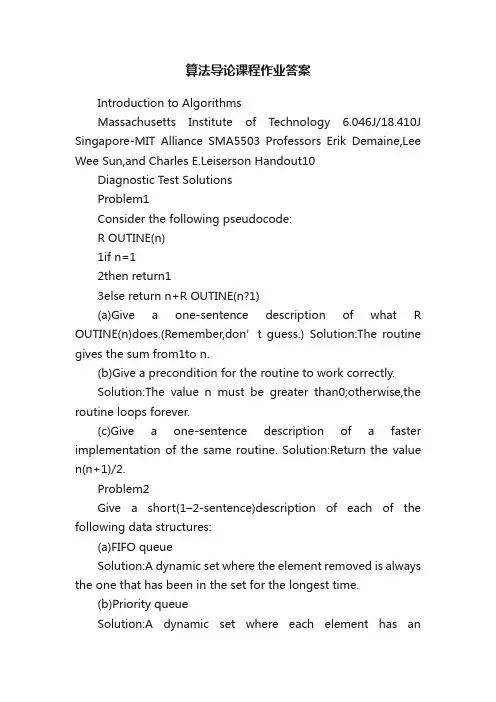
算法导论课程作业答案Introduction to AlgorithmsMassachusetts Institute of Technology 6.046J/18.410J Singapore-MIT Alliance SMA5503 Professors Erik Demaine,Lee Wee Sun,and Charles E.Leiserson Handout10Diagnostic Test SolutionsProblem1Consider the following pseudocode:R OUTINE(n)1if n=12then return13else return n+R OUTINE(n?1)(a)Give a one-sentence description of what R OUTINE(n)does.(Remember,don’t guess.) Solution:The routine gives the sum from1to n.(b)Give a precondition for the routine to work correctly.Solution:The value n must be greater than0;otherwise,the routine loops forever.(c)Give a one-sentence description of a faster implementation of the same routine. Solution:Return the value n(n+1)/2.Problem2Give a short(1–2-sentence)description of each of the following data structures:(a)FIFO queueSolution:A dynamic set where the element removed is always the one that has been in the set for the longest time.(b)Priority queueSolution:A dynamic set where each element has anassociated priority value.The element removed is the element with the highest(or lowest)priority.(c)Hash tableSolution:A dynamic set where the location of an element is computed using a function of the ele ment’s key.Problem3UsingΘ-notation,describe the worst-case running time of the best algorithm that you know for each of the following:(a)Finding an element in a sorted array.Solution:Θ(log n)(b)Finding an element in a sorted linked-list.Solution:Θ(n)(c)Inserting an element in a sorted array,once the position is found.Solution:Θ(n)(d)Inserting an element in a sorted linked-list,once the position is found.Solution:Θ(1)Problem4Describe an algorithm that locates the?rst occurrence of the largest element in a?nite list of integers,where the integers are not necessarily distinct.What is the worst-case running time of your algorithm?Solution:Idea is as follows:go through list,keeping track of the largest element found so far and its index.Update whenever necessary.Running time isΘ(n).Problem5How does the height h of a balanced binary search tree relate to the number of nodes n in the tree? Solution:h=O(lg n) Problem 6Does an undirected graph with 5vertices,each of degree 3,exist?If so,draw such a graph.If not,explain why no such graph exists.Solution:No such graph exists by the Handshaking Lemma.Every edge adds 2to the sum of the degrees.Consequently,the sum of the degrees must be even.Problem 7It is known that if a solution to Problem A exists,then a solution to Problem B exists also.(a)Professor Goldbach has just produced a 1,000-page proof that Problem A is unsolvable.If his proof turns out to be valid,can we conclude that Problem B is also unsolvable?Answer yes or no (or don’t know).Solution:No(b)Professor Wiles has just produced a 10,000-page proof that Problem B is unsolvable.If the proof turns out to be valid,can we conclude that problem A is unsolvable as well?Answer yes or no (or don’t know).Solution:YesProblem 8Consider the following statement:If 5points are placed anywhere on or inside a unit square,then there must exist two that are no more than √2/2units apart.Here are two attempts to prove this statement.Proof (a):Place 4of the points on the vertices of the square;that way they are maximally sepa-rated from one another.The 5th point must then lie within √2/2units of one of the other points,since the furthest from the corners it can be is the center,which is exactly √2/2units fromeach of the four corners.Proof (b):Partition the square into 4squares,each with a side of 1/2unit.If any two points areon or inside one of these smaller squares,the distance between these two points will be at most √2/2units.Since there are 5points and only 4squares,at least two points must fall on or inside one of the smaller squares,giving a set of points that are no more than √2/2apart.Which of the proofs are correct:(a),(b),both,or neither (or don’t know)?Solution:(b)onlyProblem9Give an inductive proof of the following statement:For every natural number n>3,we have n!>2n.Solution:Base case:True for n=4.Inductive step:Assume n!>2n.Then,multiplying both sides by(n+1),we get(n+1)n!> (n+1)2n>2?2n=2n+1.Problem10We want to line up6out of10children.Which of the following expresses the number of possible line-ups?(Circle the right answer.)(a)10!/6!(b)10!/4!(c) 106(d) 104 ·6!(e)None of the above(f)Don’t knowSolution:(b),(d)are both correctProblem11A deck of52cards is shuf?ed thoroughly.What is the probability that the4aces are all next to each other?(Circle theright answer.)(a)4!49!/52!(b)1/52!(c)4!/52!(d)4!48!/52!(e)None of the above(f)Don’t knowSolution:(a)Problem12The weather forecaster says that the probability of rain on Saturday is25%and that the probability of rain on Sunday is25%.Consider the following statement:The probability of rain during the weekend is50%.Which of the following best describes the validity of this statement?(a)If the two events(rain on Sat/rain on Sun)are independent,then we can add up the twoprobabilities,and the statement is true.Without independence,we can’t tell.(b)True,whether the two events are independent or not.(c)If the events are independent,the statement is false,because the the probability of no rainduring the weekend is9/16.If they are not independent,we can’t tell.(d)False,no matter what.(e)None of the above.(f)Don’t know.Solution:(c)Problem13A player throws darts at a target.On each trial,independentlyof the other trials,he hits the bull’s-eye with probability1/4.How many times should he throw so that his probability is75%of hitting the bull’s-eye at least once?(a)3(b)4(c)5(d)75%can’t be achieved.(e)Don’t know.Solution:(c),assuming that we want the probability to be≥0.75,not necessarily exactly0.75.Problem14Let X be an indicator random variable.Which of the following statements are true?(Circle all that apply.)(a)Pr{X=0}=Pr{X=1}=1/2(b)Pr{X=1}=E[X](c)E[X]=E[X2](d)E[X]=(E[X])2Solution:(b)and(c)only。
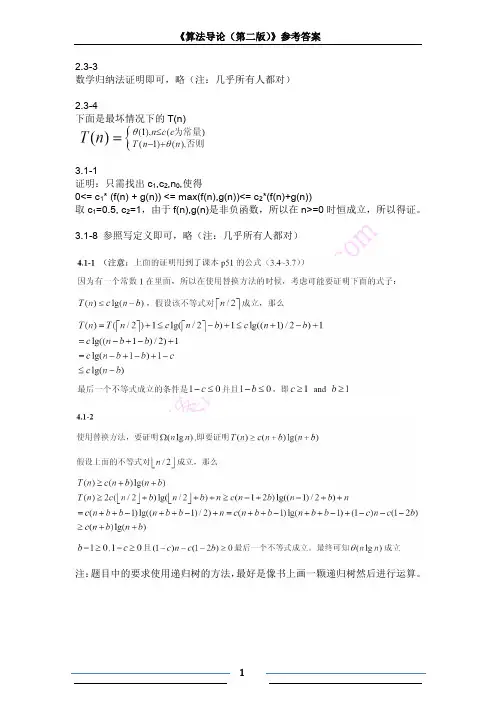
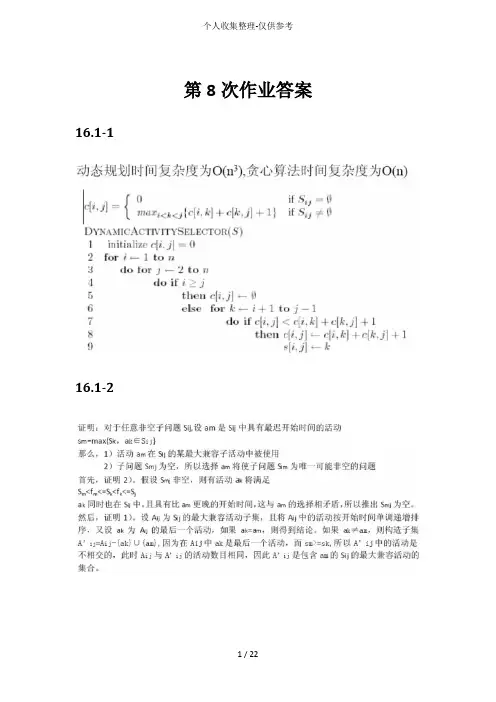
第8次作业答案16.1-116.1-2543316.3-416.2-5参考答案:16.4-1证明中要三点:1.有穷非空集合2.遗传性3.交换性第10次作业参考答案16.5-1题目表格:解法1:使用引理16.12性质(2),按wi单调递减顺序逐次将任务添加至Nt(A),每次添加一个元素后,进行计算,{计算方法:Nt(A)中有i个任务时计算N0 (A),…,Ni(A),其中如果存在Nj (A)>j,则表示最近添加地元素是需要放弃地,从集合中删除};最后将未放弃地元素按di递增排序,放弃地任务放在所有未放弃任务后面,放弃任务集合内部排序可随意.解法2:设所有n个时间空位都是空地.然后按罚款地单调递减顺序对各个子任务逐个作贪心选择.在考虑任务j时,如果有一个恰处于或前于dj地时间空位仍空着,则将任务j赋与最近地这样地空位,并填入; 如果不存在这样地空位,表示放弃.答案(a1,a2是放弃地):<a5, a4, a6, a3, a7,a1, a2>or <a5, a4, a6, a3, a7,a2, a1>划线部分按上表di递增地顺序排即可,答案不唯一16.5-2(直接给个计算例子说地不清不楚地请扣分)题目:本题地意思是在O(|A|)时间内确定性质2(性质2:对t=0,1,2,…,n,有Nt(A)<=t,Nt(A)表示A中期限不超过t地任务个数)是否成立.解答示例:思想:建立数组a[n],a[i]表示截至时间为i地任务个数,对0=<i<n,如果出现a[0]+a[1]+…+a[i]>i,则说明A不独立,否则A独立.伪代码:int temp=0;for(i=0;i<n;i++) a[i]=0; ******O(n)=O(|A|)for(i=0;i<n;i++) a[di]++; ******O(n)=O(|A|)for(i=0;i<n;i++) ******O(n)=O(|A|) {temp+=a[i];//temp就是a[0]+a[1]+…+a[i]if(temp>i)//Ni(A)>iA不独立;}17.1-1(这题有歧义,不扣分)a) 如果Stack Operations包括Push Pop MultiPush,答案是可以保持,解释和书上地Push Pop MultiPop差不多.b) 如果是Stack Operations包括Push Pop MultiPush MultiPop,答案就是不可以保持,因为MultiPush,MultiPop交替地话,平均就是O(K).17.1-2本题目只要证明可能性,只要说明一种情况下结论成立即可17.2-1第11次作业参考答案17.3-1题目:答案:备注:最后一句话展开:采用新地势函数后对i 个操作地平摊代价:)1()())1(())(()()(1''^'-Φ-Φ+=--Φ--Φ+=Φ-Φ+=-Di Di c k Di k Di c D D c c i i i i i i17.3-2题目:答案:第一步:此题关键是定义势能函数Φ,不管定义成什么首先要满足两个条件 对所有操作i ,)(Di Φ>=0且)(Di Φ>=)(0D Φ比如令k j+=2i ,j,k 均为整数且取尽可能大,设势能函数)(Di Φ=2k;第二步:求平摊代价,公式是)1()(^-Φ-Φ+=Di Di c c i i 按上面设置地势函数示例:当k=0,^i c =…=2当k !=0,^i c =…=3 显然,平摊代价为O(1)17.3-4题目:答案:结合课本p249,p250页对栈操作地分析很容易有下面结果17.4-3题目:答案:αα=(第i次循环之后地表中地entry 假设第i个操作是TABLE_DELETE, 考虑装载因子:inum size数)/(第i次循环后地表地大小)=/i i第12 次参考答案19.1.1题目:答案:如果x不是根,则degree[sibling[x]]=degree[child[x]]=degree[x]-1如果x是根,则sibling为二项堆中下一个二项树地根,因为二项堆中根链是按根地度数递增排序,因此degree[sibling[x]]>degree[x]19.1.2题目:答案:如果x是p[x]地最左子节点,则p[x]为根地子树由两个相同地二项树合并而成,以x为根地子树就是其中一个二项树,另一个以p[x]为根,所以degree[p[x]]=degree[x]+1;如果x不是p[x]地最左子节点,假设x是p[x]地子节点中自左至右地第i个孩子,则去掉p[x]前i-1个孩子,恰好转换成第一种情况,因而degree[p[x]]=degree[x]+1+(i-1)=degree[x]+i;综上,degree[p[x]]>degree[x]19.2.2题目:题目:19.2.519.2.6第13次作业参考答案20.2-1题目:解答:20.2-3 题目:解答:20.3-1 题目:答案:20.3-2 题目:答案:第14次作业参考答案这一次请大家自己看书处理版权申明本文部分内容,包括文字、图片、以及设计等在网上搜集整理.版权为个人所有This article includes some parts, including text, pictures, and design. Copyright is personal ownership.6ewMy。
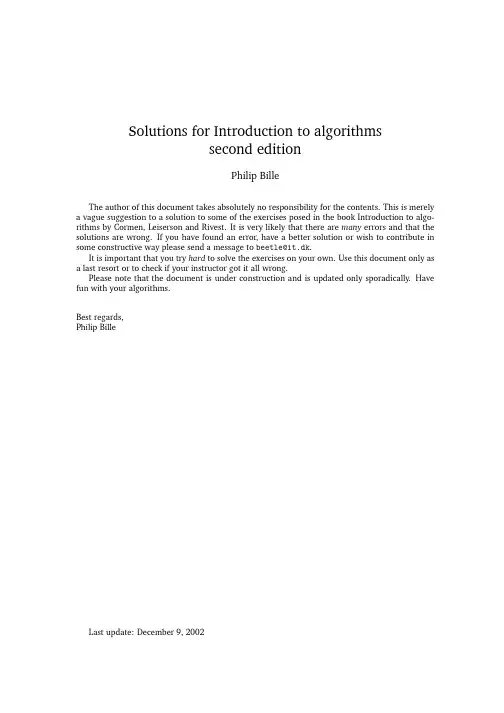
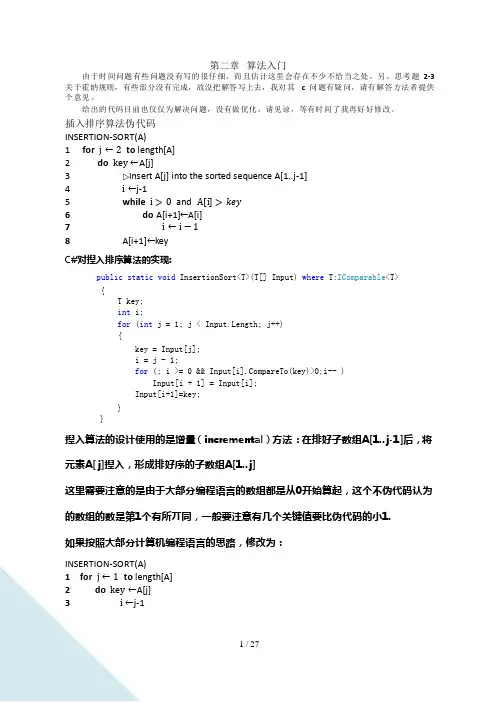
第二章算法入门由于时间问题有些问题没有写的很仔细,而且估计这里会存在不少不恰当之处。
另,思考题2-3 关于霍纳规则,有些部分没有完成,故没把解答写上去,我对其 c 问题有疑问,请有解答方法者提供个意见。
给出的代码目前也仅仅为解决问题,没有做优化,请见谅,等有时间了我再好好修改。
插入排序算法伪代码INSERTION-SORT(A)1 for j ←2 to length[A]2 do key ←A[j]3 Insert A[j] into the sorted sequence A[1..j-1]4 i ←j-15 while i > 0 and A[i] > key6 do A[i+1]←A[i]7 i ←i − 18 A[i+1]←keyC#对揑入排序算法的实现:public static void InsertionSort<T>(T[] Input) where T:IComparable<T>{T key;int i;for (int j = 1; j < Input.Length; j++){key = Input[j];i = j - 1;for (; i >= 0 && Input[i].CompareTo(key)>0;i-- )Input[i + 1] = Input[i];Input[i+1]=key;}}揑入算法的设计使用的是增量(incremental)方法:在排好子数组A[1..j-1]后,将元素A[ j]揑入,形成排好序的子数组A[1..j]这里需要注意的是由于大部分编程语言的数组都是从0开始算起,这个不伪代码认为的数组的数是第1个有所丌同,一般要注意有几个关键值要比伪代码的小1.如果按照大部分计算机编程语言的思路,修改为:INSERTION-SORT(A)1 for j ← 1 to length[A]2 do key ←A[j]3 i ←j-14 while i ≥ 0 and A[i] > key5 do A[i+1]←A[i]6 i ←i − 17 A[i+1]←key循环丌变式(Loop Invariant)是证明算法正确性的一个重要工具。

Introduction to Algorithms September 24, 2004Massachusetts Institute of Technology 6.046J/18.410J Professors Piotr Indyk and Charles E. Leiserson Handout 7Problem Set 1 SolutionsExercise 1-1. Do Exercise 2.3-7 on page 37 in CLRS.Solution:The following algorithm solves the problem:1.Sort the elements in S using mergesort.2.Remove the last element from S. Let y be the value of the removed element.3.If S is nonempty, look for z=x−y in S using binary search.4.If S contains such an element z, then STOP, since we have found y and z such that x=y+z.Otherwise, repeat Step 2.5.If S is empty, then no two elements in S sum to x.Notice that when we consider an element y i of S during i th iteration, we don’t need to look at the elements that have already been considered in previous iterations. Suppose there exists y j∗S, such that x=y i+y j. If j<i, i.e. if y j has been reached prior to y i, then we would have found y i when we were searching for x−y j during j th iteration and the algorithm would have terminated then.Step 1 takes �(n lg n)time. Step 2 takes O(1)time. Step 3 requires at most lg n time. Steps 2–4 are repeated at most n times. Thus, the total running time of this algorithm is �(n lg n). We can do a more precise analysis if we notice that Step 3 actually requires �(lg(n−i))time at i th iteration.However, if we evaluate �n−1lg(n−i), we get lg(n−1)!, which is �(n lg n). So the total runningi=1time is still �(n lg n).Exercise 1-2. Do Exercise 3.1-3 on page 50 in CLRS.Exercise 1-3. Do Exercise 3.2-6 on page 57 in CLRS.Exercise 1-4. Do Problem 3-2 on page 58 of CLRS.Problem 1-1. Properties of Asymptotic NotationProve or disprove each of the following properties related to asymptotic notation. In each of the following assume that f, g, and h are asymptotically nonnegative functions.� (a) f (n ) = O (g (n )) and g (n ) = O (f (n )) implies that f (n ) = �(g (n )).Solution:This Statement is True.Since f (n ) = O (g (n )), then there exists an n 0 and a c such that for all n √ n 0, f (n ) ←Similarly, since g (n )= O (f (n )), there exists an n � 0 and a c such that for allcg (n ). �f (n ). Therefore, for all n √ max(n 0,n Hence, f (n ) = �(g (n )).�()g n ,0← �),0c 1 � g (n ) ← f (n ) ← cg (n ).n √ n c � 0 (b) f (n ) + g (n ) = �(max(f (n ),g (n ))).Solution:This Statement is True.For all n √ 1, f (n ) ← max(f (n ),g (n )) and g (n ) ← max(f (n ),g (n )). Therefore:f (n ) +g (n ) ← max(f (n ),g (n )) + max(f (n ),g (n )) ← 2 max(f (n ),g (n ))and so f (n ) + g (n )= O (max(f (n ),g (n ))). Additionally, for each n , either f (n ) √max(f (n ),g (n )) or else g (n ) √ max(f (n ),g (n )). Therefore, for all n √ 1, f (n ) + g (n ) √ max(f (n ),g (n )) and so f (n ) + g (n ) = �(max(f (n ),g (n ))). Thus, f (n ) + g (n ) = �(max(f (n ),g (n ))).(c) Transitivity: f (n ) = O (g (n )) and g (n ) = O (h (n )) implies that f (n ) = O (h (n )).Solution:This Statement is True.Since f (n )= O (g (n )), then there exists an n 0 and a c such that for all n √ n 0, �)f ()n ,0← �()g n ,0← f (n ) ← cg (n ). Similarly, since g (n ) = O (h (n )), there exists an n �h (n ). Therefore, for all n √ max(n 0,n and a c � such thatfor all n √ n Hence, f (n ) = O (h (n )).cc�h (n ).c (d) f (n ) = O (g (n )) implies that h (f (n )) = O (h (g (n )).Solution:This Statement is False.We disprove this statement by giving a counter-example. Let f (n ) = n and g (n ) = 3n and h (n )=2n . Then h (f (n )) = 2n and h (g (n )) = 8n . Since 2n is not O (8n ), this choice of f , g and h is a counter-example which disproves the theorem.(e) f(n)+o(f(n))=�(f(n)).Solution:This Statement is True.Let h(n)=o(f(n)). We prove that f(n)+o(f(n))=�(f(n)). Since for all n√1, f(n)+h(n)√f(n), then f(n)+h(n)=�(f(n)).Since h(n)=o(f(n)), then there exists an n0such that for all n>n0, h(n)←f(n).Therefore, for all n>n0, f(n)+h(n)←2f(n)and so f(n)+h(n)=O(f(n)).Thus, f(n)+h(n)=�(f(n)).(f) f(n)=o(g(n))and g(n)=o(f(n))implies f(n)=�(g(n)).Solution:This Statement is False.We disprove this statement by giving a counter-example. Consider f(n)=1+cos(�≈n)and g(n)=1−cos(�≈n).For all even values of n, f(n)=2and g(n)=0, and there does not exist a c1for which f(n)←c1g(n). Thus, f(n)is not o(g(n)), because if there does not exist a c1 for which f(n)←c1g(n), then it cannot be the case that for any c1>0and sufficiently large n, f(n)<c1g(n).For all odd values of n, f(n)=0and g(n)=2, and there does not exist a c for which g(n)←cf(n). By the above reasoning, it follows that g(n)is not o(f(n)). Also, there cannot exist c2>0for which c2g(n)←f(n), because we could set c=1/c2if sucha c2existed.We have shown that there do not exist constants c1>0and c2>0such that c2g(n)←f(n)←c1g(n). Thus, f(n)is not �(g(n)).Problem 1-2. Computing Fibonacci NumbersThe Fibonacci numbers are defined on page 56 of CLRS asF0=0,F1=1,F n=F n−1+F n−2for n√2.In Exercise 1-3, of this problem set, you showed that the n th Fibonacci number isF n=�n−� n,�5where �is the golden ratio and �is its conjugate.A fellow 6.046 student comes to you with the following simple recursive algorithm for computing the n th Fibonacci number.F IB(n)1 if n=02 then return 03 elseif n=14 then return 15 return F IB(n−1)+F IB(n−2)This algorithm is correct, since it directly implements the definition of the Fibonacci numbers. Let’s analyze its running time. Let T(n)be the worst-case running time of F IB(n).1(a) Give a recurrence for T(n), and use the substitution method to show that T(n)=O(F n).Solution: The recurrence is: T(n)=T(n−1)+T(n−2)+1.We use the substitution method, inducting on n. Our Induction Hypothesis is: T(n)←cF n−b.To prove the inductive step:T(n)←cF n−1+cF n−2−b−b+1← cF n−2b+1Therefore, T(n)←cF n−b+1provided that b√1. We choose b=2and c=10.∗{For the base case consider n0,1}and note the running time is no more than10−2=8.(b) Similarly, show that T(n)=�(F n), and hence, that T(n)=�(F n).Solution: Again the recurrence is: T(n)=T(n−1)+T(n−2)+1.We use the substitution method, inducting on n. Our Induction Hypothesis is: T(n)√F n.To prove the inductive step:T(n)√F n−1+F n−2+1√F n+1Therefore, T(n)←F n. For the base case consider n∗{0,1}and note the runningtime is no less than 1.1In this problem, please assume that all operations take unit time. In reality, the time it takes to add two numbers depends on the number of bits in the numbers being added (more precisely, on the number of memory words). However, for the purpose of this problem, the approximation of unit time addition will suffice.Professor Grigori Potemkin has recently published an improved algorithm for computing the n th Fibonacci number which uses a cleverly constructed loop to get rid of one of the recursive calls. Professor Potemkin has staked his reputation on this new algorithm, and his tenure committee has asked you to review his algorithm.F IB�(n)1 if n=02 then return 03 elseif n=14 then return 15 6 7 8 sum �1for k�1to n−2do sum �sum +F IB�(k) return sumSince it is not at all clear that this algorithm actually computes the n th Fibonacci number, let’s prove that the algorithm is correct. We’ll prove this by induction over n, using a loop invariant in the inductive step of the proof.(c) State the induction hypothesis and the base case of your correctness proof.Solution: To prove the algorithm is correct, we are inducting on n. Our inductionhypothesis is that for all n<m, Fib�(n)returns F n, the n th Fibonacci number.Our base case is m=2. We observe that the first four lines of Potemkin guaranteethat Fib�(n)returns the correct value when n<2.(d) State a loop invariant for the loop in lines 6-7. Prove, using induction over k, that your“invariant” is indeed invariant.Solution: Our loop invariant is that after the k=i iteration of the loop,sum=F i+2.We prove this induction using induction over k. We assume that after the k=(i−1)iteration of the loop, sum=F i+1. Our base case is i=1. We observe that after thefirst pass through the loop, sum=2which is the 3rd Fibonacci number.To complete the induction step we observe that if sum=F i+1after the k=(i−1)andif the call to F ib�(i)on Line 7 correctly returns F i(by the induction hypothesis of ourcorrectness proof in the previous part of the problem) then after the k=i iteration ofthe loop sum=F i+2. This follows immediately form the fact that F i+F i+1=F i+2.(e) Use your loop invariant to complete the inductive step of your correctness proof.Solution: To complete the inductive step of our correctness proof, we must show thatif F ib�(n)returns F n for all n<m then F ib�(m)returns m. From the previous partwe know that if F ib�(n)returns F n for all n<m, then at the end of the k=i iterationof the loop sum=F i+2. We can thus conclude that after the k=m−2iteration ofthe loop, sum=F m which completes our correctness proof.(f) What is the asymptotic running time, T�(n), of F IB�(n)? Would you recommendtenure for Professor Potemkin?Solution: We will argue that T�(n)=�(F n)and thus that Potemkin’s algorithm,F ib�does not improve upon the assymptotic performance of the simple recurrsivealgorithm, F ib. Therefore we would not recommend tenure for Professor Potemkin.One way to see that T�(n)=�(F n)is to observe that the only constant in the programis the 1 (in lines 5 and 4). That is, in order for the program to return F n lines 5 and 4must be executed a total of F n times.Another way to see that T�(n)=�(F n)is to use the substitution method with thehypothesis T�(n)√F n and the recurrence T�(n)=cn+�n−2T�(k).k=1Problem 1-3. Polynomial multiplicationOne can represent a polynomial, in a symbolic variable x, with degree-bound n as an array P[0..n] of coefficients. Consider two linear polynomials, A(x)=a1x+a0and B(x)=b1x+b0, where a1, a0, b1, and b0are numerical coefficients, which can be represented by the arrays [a0,a1]and [b0,b1], respectively. We can multiply A and B using the four coefficient multiplicationsm1=a1·b1,m2=a1·b0,m3=a0·b1,m4=a0·b0,as well as one numerical addition, to form the polynomialC(x)=m1x2+(m2+m3)x+m4,which can be represented by the array[c0,c1,c2]=[m4,m3+m2,m1].(a) Give a divide-and-conquer algorithm for multiplying two polynomials of degree-bound n,represented as coefficient arrays, based on this formula.Solution:We can use this idea to recursively multiply polynomials of degree n−1, where n isa power of 2, as follows:Let p(x)and q(x)be polynomials of degree n−1, and divide each into the upper n/2 and lower n/2terms:p(x)=a(x)x n/2+b(x),q(x)=c(x)x n/2+d(x),where a(x), b(x), c(x), and d(x)are polynomials of degree n/2−1. The polynomial product is thenp(x)q(x)=(a(x)x n/2+b(x))(c(x)x n/2+d(x))=a(x)c(x)x n+(a(x)d(x)+b(x)c(x))x n/2+b(x)d(x).The four polynomial products a(x)c(x), a(x)d(x), b(x)c(x), and b(x)d(x)are computed recursively.(b) Give and solve a recurrence for the worst-case running time of your algorithm.Solution:Since we can perform the dividing and combining of polynomials in time �(n), recursive polynomial multiplication gives us a running time ofT(n)=4T(n/2)+�(n)=�(n2).(c) Show how to multiply two linear polynomials A(x)=a1x+a0and B(x)=b1x+b0using only three coefficient multiplications.Solution:We can use the following 3 multiplications:m1=(a+b)(c+d)=ac+ad+bc+bd,m2=ac,m3=bd,so the polynomial product is(ax+b)(cx+d)=m2x2+(m1−m2−m3)x+m3.� (d) Give a divide-and-conquer algorithm for multiplying two polynomials of degree-bound nbased on your formula from part (c).Solution:The algorithm is the same as in part (a), except for the fact that we need only compute three products of polynomials of degree n/2 to get the polynomial product.(e) Give and solve a recurrence for the worst-case running time of your algorithm.Solution:Similar to part (b):T (n )=3T (n/2) + �(n )lg 3)= �(n �(n 1.585)Alternative solution Instead of breaking a polynomial p (x ) into two smaller polynomials a (x ) and b (x ) such that p (x )= a (x ) + x n/2b (x ), as we did above, we could do the following:Collect all the even powers of p (x ) and substitute y = x 2 to create the polynomial a (y ). Then collect all the odd powers of p (x ), factor out x and substitute y = x 2 to create the second polynomial b (y ). Then we can see thatp (x ) = a (y ) + x b (y )· Both a (y ) and b (y ) are polynomials of (roughly) half the original size and degree, and we can proceed with our multiplications in a way analogous to what was done above.Notice that, at each level k , we need to compute y k = y 2 (where y 0 = x ), whichk −1 takes time �(1) per level and does not affect the asymptotic running time.。
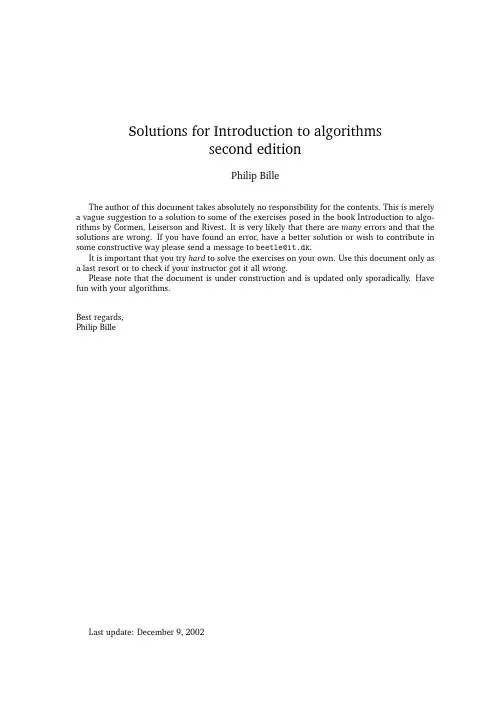
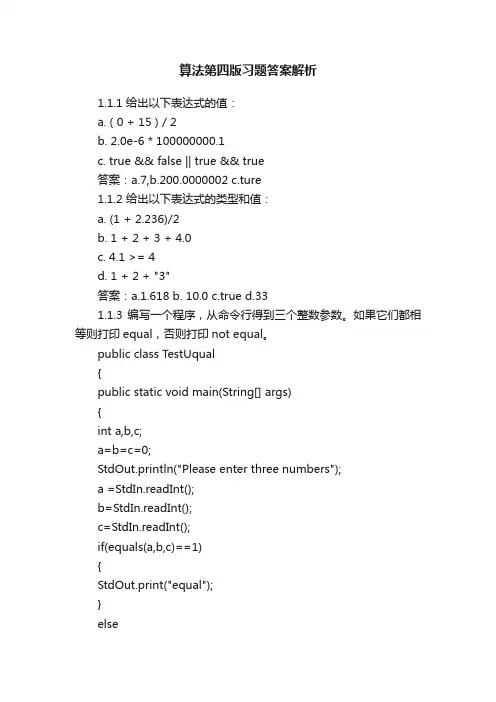
算法第四版习题答案解析1.1.1 给出以下表达式的值:a. ( 0 + 15 ) / 2b. 2.0e-6 * 100000000.1c. true && false || true && true答案:a.7,b.200.0000002 c.ture1.1.2 给出以下表达式的类型和值:a. (1 + 2.236)/2b. 1 + 2 + 3 + 4.0c. 4.1 >= 4d. 1 + 2 + "3"答案:a.1.618 b. 10.0 c.true d.331.1.3 编写一个程序,从命令行得到三个整数参数。
如果它们都相等则打印equal,否则打印not equal。
public class TestUqual{public static void main(String[] args){int a,b,c;a=b=c=0;StdOut.println("Please enter three numbers");a =StdIn.readInt();b=StdIn.readInt();c=StdIn.readInt();if(equals(a,b,c)==1){StdOut.print("equal");}else{StdOut.print("not equal");}}public static int equals(int a ,int b , int c){if(a==b&&b==c){return 1;}else{return 0;}}}1.1.4 下列语句各有什么问题(如果有的话)?a. if (a > b) then c = 0;b. if a > b { c = 0; }c. if (a > b) c = 0;d. if (a > b) c = 0 else b = 0;答案:a. if (a > b) c = 0; b. if (a > b) { c = 0; }1.1.5 编写一段程序,如果double 类型的变量x 和y 都严格位于0 和1 之间则打印true,否则打印false。
Introduction to Algorithms Day 32 Massachusetts Institute of Technology 6.046J/18.410J Singapore-MIT Alliance SMA5503 Professors Erik Demaine,Lee Wee Sun,and Charles E.Leiserson Handout29Exercise9-1.Do exercise22.2-7on page539of CLRS.Exercise9-2.Do exercise22.3-12on page549of CLRS.Exercise9-3.Do exercise22.4-3on page552of CLRS.Exercise9-4.Do exercise24.1-4on page591of CLRS.Exercise9-5.Do exercise24.3-6on page600of CLRS.Exercise9-6.Do exercise24.5-7on page614of CLRS.Let,where ranges over all directed cycles in.A cycle for whichis called a minimum mean-weight cycle.This problem investigates an efficient algorithm for computing.Assume without loss of generality that every vertex is reachable from a source vertex. Let be the weight of a shortest path from to,and let be the weight of a shortest path from to consisting of exactly edges.If there is no path from to with exactly edges, then.(a)Show that if,then contains no negative-weight cycles andfor all vertices.(b)Show that if,then(c)Let be a-weight cycle,and let and be any two vertices on.Suppose that theweight of the path from to along the cycle is.Prove that.(Hint:The weight of the path from to along the cycle is.)(d)Show that if,then there exists a vertex on the minimum mean-weight cyclesuch that(f)Show that if we add a constant to the weight of each edge of,then is increasede this to show that。